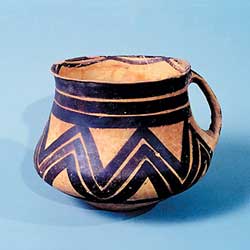
On display in the cold basement here are 3,000 exhibits that the museum owner collected on his trips to outlying areas of China. The exhibition is made up of four parts: ancient and painted pottery, ends of eaves tiles, and sealed clay works. His own creative works including calligraphy, paintings and installations are also on show.
Eye-catchers: The best exhibits are the 400 rare eave tile ends (wa dang) dating back as early as the Qin Dynasty (221-206 BC). It is China's first systematic exhibition of wa dang, an integral part of ancient Chinese architecture, decorating the eaves and protecting houses from wind and rain. On the half-circled or full-circled eave tile ends, there are auspicious Chinese characters, a good mix of arts such as calligraphy, sculpture, myth, history and folklore.
Another selection is sealed clay (feng ni ), particles of mud on which seals were chopped to leave signs of identification. Feng ni was used before the invention of paper to bear seals in China. On the clay there are seen holes on both ends, where threads used to go through to bind identified letters, documents and cargoes. All kinds of styles of Chinese characters appear on the sealed clay, which are valuable materials for archaeological studies of times as early as the Warring States period (475-221 BC).
English and Japanese tour guides need to be booked in advance. So do a short two-hour visit (200 yuan, or US$25) doing rubbings from inscriptions on stone tablets or sealed clays.
Add: 12 You'anmennei Xidajie, Xuanwu District. 12
Entry ticket: 20 yuan (US$2.5)
Opening hours: 10:00AM - 5:00 PMm (except Monday)
Traffic: Take the subway to Changchunjie, then take bus 59, 19, 10 and get off at Nancaiyuan, go south to find a lane to the north gate of the Daguanyuan Hotel, pass the Beijing Currency Printing Factory, and walk 200m eastward down the lane.
Tel: 86-10-63538811
(China Daily March 3, 2006)
|

